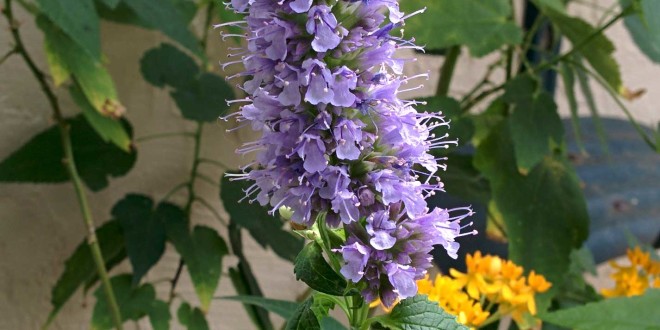Okay. I bought this plant because of its name. There were no photos of the flowers; the plant was not yet in bloom. I just loved the 1980s BBC four-year series starring Rowan Atkinson (as Edmund Blackadder) and Tony Robinson (as Baldrick). When the plant finally bloomed last week, I was pleasantly surprised by its purple flower stalk. But, as Blackadder said, “Leave me alone, Baldrick. If I wanted to talk to a vegetable, I would have bought one at the market”.
Culture
Easily grown in average, medium moisture, well-drained soils in full sun to part shade. Best in full sun. Good soil drainage is essential. Plants will perform poorly and may not survive winter in hard clay soils that retain moisture. Plants tolerate heat and some dry soils once established. Deadhead spent flowers to promote additional bloom. Agastache hybrids are typically winter hardy to at least USDA Zone 6. Where winter survival is a potential problem, plants should be sited in protected locations (e.g., southern exposures) with leaf and flower stems being left in place over winter for additional protection. Sandy/gravelly mulches will protect plants and help to avoid onset of rot. Hybrids grown from seed will usually not come true.
Noteworthy Characteristics
Agastache, commonly called giant hyssop, is a genus containing about 30 species of upright herbaceous perennials, most of which are native to North America.
Agastache hybrids often have showier flowers and better winter hardiness than species plants. Hybrid flowers come in a variety of different flower colors including shades of red, orange, pink, yellow and white. Hybrids typically feature dense terminal spikes of tiny 2-lipped tubular flowers which bloom mid-summer to fall in many-flowered verticillasters (false whorls) atop 2-4’ tall stiff square stems clad with opposite pairs of serrate, fragrant (anise/licorice scented) gray-green to medium green leaves. Flowers are attractive to bees, hummingbirds and butterflies.
Agastache comes from the Greek words agan meaning much and stachys meaning grain stalk in reference to the abundant flower spikes which appear over its long growing season.
‘Black Adder’ is an upright, clump-forming giant hyssop that grows to 2-3′ tall. It is a hybrid resulting from a cross between A. rugosum and A. foeniculum. It is noted for its long summer-to-frost floral display of tubular, 2-lipped, smoky red-violet flowers that bloom in showy, bottle-brush, terminal spikes (to 6-8″ long). Flowers appear in many-flowered verticillasters (false whorls) which are densely packed to form the flower spikes. Flowers emerge from nearly black buds. Aromatic (anise/licorice scented), lance-shaped to ovate leaves are blue green. Flowers are attractive to bees, hummingbirds and butterflies.
Problems
No serious insect or disease problems. Crown/root rot may develop in poorly drained soils. Watch for rust, powdery mildew and leaf spots.
Garden Uses
Bold, aromatic, long-blooming perennials for sunny borders, cottage gardens or butterfly gardens. Effective near patios and along walkways. Good cut flower.
Common Name: giant hyssop
Type: Herbaceous perennial
Family: Lamiaceae
Zone: 6 to 9
Height: 2.00 to 3.00 feet
Spread: 1.50 to 2.00 feet
Bloom Time: June to September
Bloom Description: Smoky red violet
Sun: Full sun to part shade
Water: Medium
Maintenance: Medium
Flower: Showy, Fragrant
Leaf: Fragrant
Attracts: Butterflies
Tolerate: Deer








